Supply-exhaust ventilation device with heated air for an example of the EKS system.
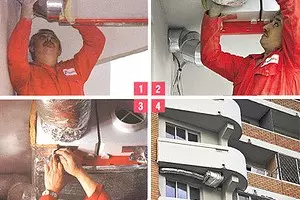
The reasons for many of our dismisses are associated either with too dry and cold air, or with too wet and warm. That's why we would gladly play at home in moderation of the wet climate of Yalta, which is useful to everyone, and not a tropical climate, which is withstanding people only with absolutely healthy light, although in both cases the air may be the same warm
In the two previous magazine rooms, we talked about the air treatment systems of the apartment: about local exhaust ventilation and air conditioning ventilation. The first of them is easy to handle, inexpensive and provides a flow of fresh air, without heating it, and it does not differ from the usual open window. The second system not only gives the influx of fresh air and cleans it, but also heats up to the temperature desired in each room, but it is more than ten times more expensive and requires complex installation of equipment.
Now we will talk about the system of supply and exhaust ventilation with heating of the supply air, which occupies an intermediate pricing and its capabilities the position between the two previously described. Such systems offer on the Russian market such firms such as Japanese Daikin, Swedish-Swiss ABB, Swedish Ostberg, German Maico and EMM, French Aereco, Austrian Frivent, Belgian Renson. Some systems can be installed independently, while others with the help of a company specialist.
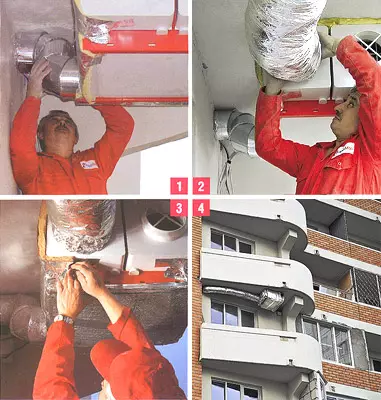
[2] The connection of the air duct at the input of the Akor unit for the fence of the removed air from the apartment.
[3] Heat and sound insulation block "Akor".
[four] Fully mounted "AKOR" block to panels and finishing and finishing and after. Preparation of food, washing, making a shower, wet cleaning and even the release of moisture with home plants lead to an increase in air humidity in the room. In addition, the temperature of the inner surface of the window glass at the air temperature in the room 20c and on 0 ° C street depends on the type of glazing and will be:
11c for a single-chamber glass glass (with two glasses),
16C for two-chamber glass windows (with three glasses),
18C for a two-chamber glass window for the use of glass with heat transfer coating.
In the first case, condensate is possible, and in the latter. If the air in the room is wet, then it should be replaced, since the formation of condensate in the corners and on the slopes of windows, for furniture and paintings can lead to the appearance of stains of dampness, and with the time of mold. The quantity of the dry fresh air is reduced by the amount of condensate, and when a certain humidity is reached, the formation of condensation will stop. Thus, the ventilation is necessary not only to ensure the receipt of fresh air, but also for the output of water vapor.
In addition, it should be borne in mind that according to GOST 30494-96 "buildings residential and public. The parameters of the microclimate in the premises" the temperature difference in the height of the room should not exceed 3c. In order to preserve the walls of the walls without damage for a long time and prevent the drying of furniture and wooden doors, the temperature in the apartment should be maintained at no lower than 17C. Thus, the fresh atmospheric air is supplied to the apartment with the help of supply ventilation, it is also necessary to warm up (and in the heat, of course, cool).
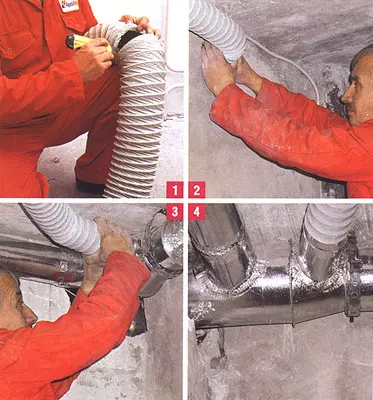
[2] Flexible air duct can be easily skipped through a hole in the interroom.
[3] Installation of a flexible air duct to splitter.
[four] The splitter in the assembled form. With an average atmospheric temperature -15c, when using an electrocalorifer for heating the supply air, electricity is consumed by more than 0.01kW * h per 1m3 room volume, which for apartments with an area of 100m2 with a ceiling height of 2.8m will be about 3kW * h. This value is comparable to electricity consumption by all the others, together taken, household appliances used in the apartment. With a harsh winter, energy consumption will increase even more significant.
With the effective operation of the central heating system, another source of heating of the supply air-removed from the premises was very economically economy, which is of the temperature, which must be heated by the trimmed. The heat recuperator is built into the supply-exhaust ventilation unit, and its surface consists of a plurality of parallel metal or non-metallic plates with channels for serial alternation of planes that are added atmospheric and removed air.
Adhesive atmospheric air heating devices
Heating or air cooling is produced using heat exchangers. They are superficial and contact, and the first uses the first to be used in everyday life, in which the warm and cold medium are separated by a partition transmitting heat. If the surface heat exchanger increases the temperature in the direction where the warm air comes from, then it is called the recuperator (from the Latin recuperator - returning). It is water, air (steam) and electric according to the second medium used, as well as direct-flow, countercurrent or mixed type (cross, repeatedly cross, etc.), depending on the direction of the relative motion of the media. The amount of heat transmitted for any recuperator is proportional to the difference in the temperature of the media, the surface area and the heat transfer coefficient of the partition material.The most simple and convenient for heating the supply air surface straight-flow electric heat exchanger, or electrocalorifer. It has the main element is a tubular electric heater (TEN), having a high temperature in working condition and transmitting heat blowing it into the air duct at atmospheric air.
A plate heat recovery is more complex, which uses ribbed plates with channels for cross-flows of removed and atmospheric air. These plates significantly increase the efficiency of heat exchange due to an increase in surface area, since heat transfer occurs at a smaller temperature difference than in the electrocavoroque. When passing through the recuperator, colder dyed air heats up, and warmer, giving heat, becomes colder.
Not all the owner of the apartment will want to drill holes in the walls of all rooms for installing the supply valves, which is necessary when installing forced exhaust ventilation (see reporting "Own exhaust ventilation" BN1 in 2000g.). In addition, the constantly working fan unit is a source of noise, which makes an additional inconvenience. It is much easier to take this block outside the apartment, for example, to install on the loggia or from the outside of the building, and to feed the atmospheric air through one common air duct, and then distribute in all rooms using branched portions of the flexible air duct.
Examples of moisture change and air temperature when using Daikin ventilation unit
| Cooling | Air Parameters (Temperature, C and Relative Humidity,%) | ||||
| Outside | Inside | Outside | Inside | Outside | Inside |
| 35С, 46% | 22c, 50% | 27c, 47% | 21c, 60% | 24c, 65% | 22c, 50% |
| Parameters of supply air | |||||
| 25.9C, 49% | 22.4C, 61% | 22.5C, 57% | |||
| Heat | Air Parameters (Temperature, C and Relative Humidity,%) | ||||
| Outside | Inside | Outside | Inside | Outside | Inside |
| -10С, 85% | 24c, 50% | -1c, 100% | 20c, 63% | 10c, 80% | 22c, 50% |
| Parameters of supply air | |||||
| 15.9C, 50% | 15c, 72% | 19.1C, 52% |
Consider an inexpensive and fairly simple system "EKECTN", mounted by the company CJSC "Engineering Equipment" with a block of supply and exhaust ventilation "Akor", inside which is located a recovery. With the help of this system, the air is closed from the street forcibly and enters its "heart" - the "AKOR" block containing two centrifugal fans for supply and exhaust air and four nozzles with a diameter of 150mm for exhaust air removed from individual rooms, the intake of fresh atmospheric, feed Supply air in an apartment and exhaust emissions. Fresh air is supplied with a supply fan first to the recuperator of a block where it heats up, after which it enters separate apartments. The streams of the removed air with an increased moisture content and odors are collected in the air duct, then pass through the cross channels of the recuperator with polypropylene plates of the Akor block, are connected to a single stream, which is ejected to the exhaust fan outward. When system performance up to 320 m3 / h, the maximum allowable length of each of the air ducts (supply and exhaust) is 18 m. The noise level of the operating fans should not exceed 40 DB, and when connecting to the network, there is no need to ground the housings of their engines.
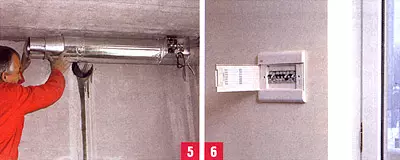
[6] Switch modes of operation of the Akor block. For free movement of air from some apartments to others, it is necessary to provide a slot area around 180cm2 in each door or wall, as in the case of the previously described forced exhaust ventilation. The system is designed for a permanent job, and each fan at maximum performance consumes 60W electricity. About half of the heat of the removed air returns back, so during normal operation of the central heating system and the absence of frosts of this heat is enough to maintain a comfortable room in the room without additional heating. At a temperature on the street, it can be enabled in advance the electrocalorifer in advance in the system, which would additionally heated the trim air after the recuperator. The capacity of such an electric unit for an apartment of up to 100m2 does not exceed 1,5kW compared with those 3kW, which are required in the absence of a recuperator.
The only inconvenience of the block is the need for a periodic removal of water condensing in the recuperator channels when cooled of warmer air due to the excess of water vapor in it. Condensate flows across the channels, assembled in the heat insulated pallet provided and the external location of the unit simply drips from a special tanning tube. The electronic device prevents frosting condensate in channels at temperatures below 0s.
Communication between temperature and humidity
The air ability to absorb moisture depends on its temperature: the lower, the less moisture is absorbed. Thus, in 1m3 air at T 20c, it may be in suspended state of 17g moisture, at t 10c- only 9g and with a decrease in T C20C to 10C from each cubic meter of air 8g water in the form of small droplets (condensate).
When evaluating air humidity, the concept of relative humidity is most often used, that is, the ratio of the content of water vapor in the air to the maximum possible value at this temperature. This ratio is often expressed as a percentage. Comfortable for different people, the air temperature values are in the range from 24 to 227s in the summer and from 20 to 24C in winter at a humidity of from45 to 16%. With relative humidity not exceeding 50%, some feel comfortable and at temperatures of 16 or 28c. If the humidity reaches up to 80%, then at 16c almost everyone becomes a little zyabko, and at 28c- stuffed.
The reasons for many of our unobrays are associated either with too dry, or with too wet air (minimize less than 35% or more than 80%, respectively). That is why we, for example, in winter to dry and warm air, always strive to add it cold, but wet atmospheric. Our Outdoor Fortoop always intuitively instills hope for achieving parameter values if not favorable, then at least satisfactory climate. In fact, the accurate ratios of relative humidity, temperatures and volumes of the mixed parts of air are calculated using special psychrometric diagrams (this procedure is simple, but very tedious, so we will not tell about it). These relations are used in air treatment systems, usually controlled by microprocessor.
A slightly different version of the block of supply and exhaust ventilation was developed by Daikin: it regulates not only heat transfer, but also in some limits of air humidity. The plates of the recuperator are made of thick paper with a special impregnation, which gives them hygroscopicity, that is, the property absorb moisture like a waters. The water released in the channel is not condensed, but penetrates into the adjacent channel and is carried out in a flux of drier air in the opposite direction. That is why in the cold season when atmospheric air land than in the summer, moisture returns together with the supply air into the room. In the summer, on the other hand, it penetrates the channel with a more humid atmospheric air into the channel with removable air and is thrown out. The swables are given examples of the values of the parameters of atmospheric, supply and remote air when using this unit.
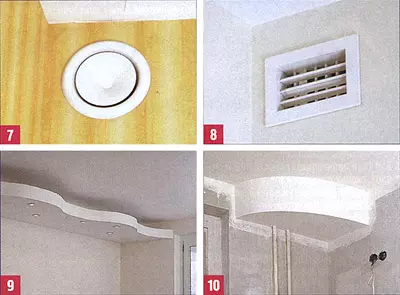
[eight] This looks after the final decoration of the room the ventilation grille installed on the trim duct.
[9], [10] Options for decorating air ducts in the apartment. The temperature sensors are installed in the channels of the removed and atmospheric air, due to which you can maintain comfortable temperature and air humidity in the room automatic inclusion and disconnection of the heat exchange process using microprocessor controls and the remote control to it. This mode is particularly effective when the system of central heating is soft in winter and in the offseason.
So, Daikin has solved two problems of the supply and exhaust ventilation: the ability to adjust the humidity of the air and the absence of condensate in the block. But the efficiency of the block can still be enhanced when used with air conditioning: the entire system is controlled by the remote control of the air conditioner, which saves electricity and provides optimal air conditional parameters in the warm and cold periods of the year.
RECOMMENDATIONS FOR INSTALLATION AND CARE FOR THE SYSTEM
To reduce the aerodynamic resistance, the Akor block is more convenient to place in such a way that the total length of the air ducts is as short as possible.
Installing one or more silencers makes ventilation almost silent. ABB recommends mounting each of them near the place of attachment of the end of the flexible air duct to the wall for the greatest reduction in noise level.
If at temperatures below 0 ° C incoming difty air as a result of heat exchange with removable remains not warm enough, it is better to install a 1.5 kW electrocavororal electrocavoroifer.
The deposition of dust and foreign particles on the inner surfaces of the recuperator channels gradually reduces heat transfer efficiency. Once a year, as a rule, in the summer, you need to remove the recuperator of the Akor block and place for several hours into the soap solution, then rinse with a stream of clean water. But for the recuperator of the Daikin block, you should use dry cleaning with a vacuum cleaner with a brush. The intervals between cleaning should not exceed two years, although it is better to do it more often.
Periodically, it is necessary to clean the "AKOR" block from the deposited outside of the dust, after turning off the ventilation and disconnecting the latch of the fastening of its front panel. The intervals between cleanlies depend on the degree of contamination of atmospheric air and for the industrial area of the city can be one month, and for the "sleeping" - one quarter.
If the Daikin malfunction occurs, the block microprocessor will give its code on the remote remote control. Notify this code by a specialist of the service company, and it will quickly determine the reason for refusal.
